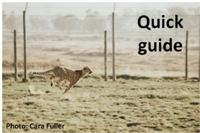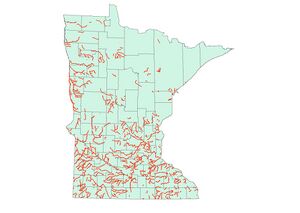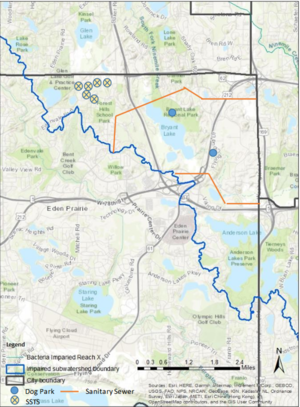
Guidance for meeting bacteria TMDL MS4 permit requirements
This page provides guidance for MS4 (Municipal Separate Storm Sewer System) permittees who have total maximum daily load (TMDLs) wasteload allocations (WLAs) for bacteria.
For more information on bacteria in stormwater, link here. For more information on pathogens in urban stormwater link here.
Contents
Bacteria TMDLs
Escherichia (E). coli is an indicator bacteria, meaning it indicates the potential presence of disease causing pathogens that can be harmful to human health. Currently there are 172 impaired waters that have total maximum daily load (TMDLs) that include MS4 (Municipal Separate Storm Sewer System) wasteload allocations (WLAs) for bacteria. Click here to link to MPCA's impaired waters website. The adjoining map illustrates U.S. EPA-approved listings for E. coli and fecal coliform.
Permit requirements for bacteria TMDLs
MS4 permit requirements for permittees that have an applicable wasteload allocation (WLA) for bacteria include the following:
Section 22.3: If the permittee has an applicable WLA where a reduction in pollutant loading is required for bacteria, the permittee must maintain a written or mapped inventory of potential areas and sources of bacteria (e.g., dense populations of waterfowl or other bird, dog parks).
Section 22.4: If the permittee has an applicable WLA where a reduction in pollutant loading is required for bacteria, the
permittee must maintain a written plan to prioritize reduction activities to address the areas and sources identified in
the inventory in item 22.3. The written plan must include BMPs the permittee will implement over the permit term, which may include,
but is not limited to:
a. water quality monitoring to determine areas of high bacteria loading;
b. installation of pet waste pick-up bags in parks and open spaces;
c. elimination of over-spray irrigation that may occur at permittee owned/operated areas;
d. removal of organic matter via street sweeping;
e. implementation of infiltration structural stormwater BMPs; or
f. management of areas that attract dense populations of waterfowl (e.g., riparian plantings).
Guidance for meeting bacteria TMDL permit requirements
The MS4 permit employs a performance based approach for meeting bacteria TMDLs. This means that permittees must perform certain actions intended to reduce bacteria loads from stormwater runoff rather than quantify loads or load reductions associated with implementation of best management practices (BMPs).
Inventorying potential areas and sources of bacteria
Section 22.3: If the permittee has an applicable WLA for bacteria, the permittee must maintain a written or mapped inventory of potential areas and sources of bacteria (e.g., dense populations of waterfowl or other bird, dog parks).
The purpose of this permit requirement is to identify areas that may contribute significant bacteria loads to stormwater runoff and receiving waters. Bacteria are ubiquitous and there are many potential sources in urban areas. Common sources for bacteria include sanitary sewer overflow locations, areas that attract nuisance birds and/or wildlife (parks, golf courses, etc.), dog parks, and known septic systems (see adjoining table for additional potential sources). The intention of this permit requirement is to identify areas where bacteria loading may be particularly high so that permittees can implement activities to reduce or eliminate the bacteria source.
The adjoining table and a section in the manual, Stormwater management for bacteria, may be helpful in identifying areas for inventoring and mapping.
Potential sources of bacteria and actions to address
Link to this table
| General Category | Source | Action |
|---|---|---|
| Municipal Sanitary Infrastructure | Combined Sewer Overflows1 | Replace infrastructure, if possible |
| Sanitary Sewer Bypasses/Overflows | Line sanitary sewer pipes | |
| Inflow and Infiltration | Minimize and eliminate through repairing damaged sewers | |
| Illicit discharges from unsewered communities | Detect and eliminate illicit discharges | |
| Human Sanitary Sources | Leaky/failing septic systems | Update and enforce subsurface sewage treatment system (SSTS) ordinances |
| Educate homeowners on septic system maintenance and opportunities for replacement | ||
| Implement higher standards for setbacks for installing septic systems near receiving water bodies | ||
| Porta-potties | Ensure construction site temporary toilets have appropriate pollution prevention BMPs | |
| Domestic pets | Dogs, cats, dog parks, walking trails, residential yard and sidewalk runoff (spring runoff after winter accumulation) | Establish pet waste disposal stations along trails, in dog parks, etc. |
| Pass and enforce pet waste ordinances and educate pet owners about them | ||
| Add infiltration BMPs downstream of parks/residential areas and upstream of stormwater pipes (i.e., somewhere between the park/residential area and the stormwater outfall so as to intercept and infiltrate some or all of the flow from these areas) | ||
| Reduce transport from parks, residential, and other areas by the use of buffer zones and other disconnection of flow pathways (e.g. impervious surface, disconnection, downspout disconnection) | ||
| Urban wildlife | Rodents (raccoons, squirrels, etc.), deer, etc., birds (geese, ducks, swallows, etc.), areas where wildlife congregate such as fields, parks, and golf courses | Wildlife feeding bans and control of nuisance populations, including ducks and geese and other wildlife |
| Remove community facilities such as vending machines for feeding ducks and geese | ||
| Add buffers in riparian zones near waterbodies to deter waterfowl congregation | ||
| Consider wildlife barriers if wildlife (e.g. raccoons) are found to be living in storm sewers | ||
| When possible, use infiltration BMPs instead of detention ponds in residential developments and other areas where wildlife may congregate | ||
| Other Urban Sources (non-stormwater) | Excessive irrigation/overspray | Assess the extent to which irrigation over-spray occurs at city-owned facilities and eliminate overspray as appropriate |
| Education on water conservation | ||
| MS4 Infrastructure | Illicit sanitary connections to MS4 | Detect and eliminate illicit discharges |
| Leaky sewer pipes | Line sewer pipes | |
| Biofilms/regrowth | Reduce dry weather flows, which provide conditions that promote bacteria growth. Dry weather flows could be from night time irrigation of lawns/parks or leaky stormsewer pipes. | |
| Decaying plant matter, litter, and sediment in the storm drain system | Enhance street sweeping program. | |
| Prevent the discharge of grit chamber clean out effluent | ||
| Remove leaf litter and soil in street and gutters: implement an Adopt-a-storm drain program | ||
| Other Natural Sources | Stream Bank Erosion | Streambank restoration |
1Note only a few combined sewers remain in Minneapolis
*This table was created using information from the Upper Mississippi River Bacteria TMDL Study (2014) and Protection Plan and the Upper Mississippi River Bacteria TMDL Implementation Plan (2016), Pathogens in Urban Stormwater Systems (2014), and the Minnehaha Creek Bacterial Source Identification Study (2017).
Many TMDL reports contain information on potential sources and relative contributions of sources in the TMDL impaired subwatershed. For example, the Vermillion River Watershed TMDL Report (2015) includes the adjoining table that shows potential sources of bacteria in each impaired reach. These reports may provide specific sources to the impaired water, although most TMDL reports provide general information about bacteria sources.
You may also choose to create a mapped, rather than written, inventory of potential sources of bacteria. This could be done using Geographic Information System (GIS) to show areas where there may be potentially high levels of bacteria. A hypothetical example is shown in the adjacent image. Note that the map shows the subwatershed area of the impaired reach outlined in blue and the jurisdictional boundary outlined in black. The sources indicated on the map include subsurface sewage treatment system (SSTS), sanitary sewers, and dog parks. In this hypothetical example the MS4 permittee (Municipal Separate Storm Sewer System) may choose to focus their initial implementation efforts on working with residents to update any non-compliant septic systems, detecting and eliminating any illicit discharges from sanitary sewers, and implementing an education campaign focused on dog park users.
You may also want to consider further activities to determine potential sources of bacteria. Some voluntary activities may include the following.
- Conduct an E. coli monitoring study along the impaired stream to help identify hot spots of higher bacteria concentrations. Monitor the tributaries flowing into the stream and consider monitoring stormwater outfalls. Sampling at the correct times is critical if this approach is utilized. See bacteria monitoring guidance for more information.
- Identify subwatersheds for each stormwater outfall or tributary to the impaired stream, making note of potential high-loading features such as wildlife congregation areas, parks (especially dog parks) and sanitary systems that are potentially located upstream of stormwater systems. Stormwater outfall monitoring could be targeted based on the results from the written and/or mapped inventory.
- Visually inspect stormwater outfalls to the impaired stream during dry weather flow for flows, odor, color, condition, etc. that would be indicative of an illicit discharge. Take the appropriate actions to eliminate the illicit discharge.
Maintain a written plan to prioritize reduction activities
Section 22.4: If the permittee has an applicable WLA for bacteria, the permittee must maintain a written plan to prioritize reduction activities to address the areas and sources identified in the inventory in item 22.3. The written plan must include BMPs the permittee will implement over the permit term, which may include, but is not limited to:
a. water quality monitoring to determine areas of high bacteria loading;
b. installation of pet waste pick-up bags in parks and open spaces;
c. elimination of over-spray irrigation that may occur at permittee owned/operated areas;
d. removal of organic matter via street sweeping;
e. implementation of infiltration structural stormwater BMPs; or
f. management of areas that attract dense populations of waterfowl (e.g., riparian plantings).
MS4s with a bacteria WLA are required to develop and maintain a written plan to prioritize reduction activities to address bacteria. Potential sources of bacteria and potential activities to address each source were discussed above). A written plan could include information contained in the tables below (Strategies and actions proposed for the Coon Creek subwatershed; Priority Actions for Shingle Creek Subwatershed).
Address human sources of bacteria first since they represent a clear human public health risk (e.g. failing septic systems, illicit discharges, etc.). Streams that exceed the State water quality standards for E. coli may have increased levels of waterborne pathogens that can be harmful to human health when the streams are used as drinking waters sources and for recreational activities. It is also important to prioritize implementation activities that reduce bacteria to impaired waters that people use for drinking and/or recreating (fishing, swimming, boating, etc.).
The following elements may be included for each implementation activity when developing a written plan.
- Priority level (high, medium, low)
- Cost estimates (staff time, construction and operation and maintenance costs).
- Schedule (target year for completion, duration)
- Scale (estimated magnitude in watershed, estimated scale of adoption. See tables below.)
- Funding options (grants, stormwater utility fee, etc.)
- Potential partners (watershed management organizations, soil and water conservation districts, cities, townships, counties, etc.)
Information for identifying potential sources of bacteria and possible implementation activities to reduce bacteria in the impaired watershed may be available in the following.
- TMDL Reports
- TMDL Implementation Plans
- Watershed Restoration and Protection Strategies Reports
- Local water plans (e.g., Watershed Management Organizations, Watershed Districts, Soil and Watershed Districts, Conservation Districts, County, City, and One Watershed One Plans)
- Source Water Protection Plans
For example, the Coon Creek Watershed District Watershed Restoration and Protection Strategies Report (2016) includes the following implementation table that could be used to inform the written plan:
Strategies and actions proposed for the Coon Creek subwatershed (See Table 10 of the report).
Link to this table.
| Strategies | Strategy types and estimated scale of adoption needed to meet final water quality target | Interim 10-year milestone | Partners |
|---|---|---|---|
| Address failing septic systems | ID and upgrade all ITPHS systems | ID process/upgrades complete | Watershed District, Cities, County |
| ID and upgrade all non-compliant SSTS near surface water resources | ID process complete | Watershed District, Cities, County | |
| Improve upland/field surface runoff controls | Identify areas in need of riparian buffers; install/enhance 15-25 foot buffers where practical | Year 2: identify high priority areas; Year 10: 20% of buffers completed | Watershed District, Cities, Soil and Water Conservation District |
| Pet waste management | Provide outreach and education materials to residents regarding appropriate pet waste management | Increased public awareness | Watershed District, Cities, Soil and Water Conservation District |
| Ordinance enforcement | Ongoing | Watershed District, Cities | |
| New/emerging technologies | Follow new and emerging technologies (e.g. biochar, etc.) | Install 2 projects/devices aimed to reduce E. coli | Watershed District, Cities |
The Upper Mississippi River Bacteria TMDL Implementation Strategy report (2016) includes the information in the adjoining table that could be used to inform the written plan.
Priority Actions for Shingle Creek Subwatershed (Table 66).
Link to this table.
| Priority Timeframe1 | Action | Estimated Effectiveness of Practice2 (up to) | Estimated Magnitude in Watershed | Implementation Cost3 | |
|---|---|---|---|---|---|
| High | Identify and map potential bacteria hotspots | Staff time | |||
| High | Update and enforce pet waste ordinances | ~23,000 acres developed land but target near stream first | Staff time | ||
| High | Conduct public outreach to ensure that pet owners pick up pet waste and comply with pet waste ordinances | Staff time | |||
| High | Direct flow pathways between contributing areas to infiltration/treatment basins or away from impervious areas to prevent direct pathway to receiving waters | ||||
| High | Develop, implement, and enforce a program to detect and eliminate illicit discharges | ||||
| High | Inspect/monitor stormwater outfalls to reduce dry weather flow | Staff time | |||
| Medium | Install Filtration/Biofiltration BMPs where feasible | 35% | $8,000-20,000/ac | ||
| Low | Install filter strips/buffers near waterbodies to deter waterfowl from congregating and conduct public outreach on wildlife feeding | 91% | ~53 acres (assume 11 miles of stream; 20ft buffer) | $600-1,000/acre of buffer | |
| Low | Conduct septic system inspections as warranted and bring all imminent threat to public health septic systems into compliance with ordinances | 100% | ~22 systems | $200-300 (inspection) $7,500 per system (if replacement required) |
1Priority is based on recommended timeframe to continue or start (not complete) implementation activities: High = 1-2 years, Medium = 2-5 years, Low = 5-10 years
2Estimated effectiveness of practice refers to the reduction of bacteria concentrations in runoff to receiving waterbodies
3Costs based on NRCS EQIP Payment Schedules
References
- Minnesota Pollution Control Agency (MPCA). 2014. Upper Mississippi River Bacteria TMDL Study and Protection Plan. wq-iw8-08e. Prepared by Minnesota Pollution Control Agency and Emmons and Olivier Resources, Inc.
- Minnesota Pollution Control Agency (MPCA). 2016. Upper Mississippi River Bacteria TMDL Implementation Plan. Prepared by Minnesota Pollution Control Agency and Emmons and Olivier Resources, Inc.
- Sadowsky, M., C. Staley, and S. Gruber. 2017. Minnehaha Creek Bacterial Source Identification Study—Sources of E. Coli in an Urban Environment. Presentation at Minnesota Water Resources Conference, St. Paul, MN. October 18, 2017.
- Urban Water Resources Research Council. 2014. Pathogens in Urban Stormwater Systems. Prepared by Urban Water Resources Research Council Pathogens in Wet Weather Flows Technical Committee, Environmental and Water Resources Institute, American Society of Civil Engineers
Related pages
TMDL MS4 permit guidance
- Guidance for meeting chloride TMDL MS4 permit requirements
- Guidance for meeting bacteria TMDL MS4 permit requirements
- Guidance for meeting dissolved oxygen or oxygen demand TMDL MS4 permit requirements
- Guidance for meeting temperature TMDL MS4 permit requirements
- Guidance for categorical TMDLs
- Forms, guidance, and resources for completing the TMDL annual report form
- Baseline year
- Summary of TMDL requirements in stormwater permits
- Interpreting wasteload allocations based on flow/load duration curves
TMDL toolkit for MS4 permit compliance

- Overview of models used to meet MS4 TMDL permit requirements
- Recommendations and guidance for utilizing P8 to meet TMDL permit requirements
- Recommendations and guidance for utilizing WINSLAMM to meet TMDL permit requirements
- Recommendations and guidance for utilizing the MIDS calculator to meet TMDL permit requirements
- Recommendations and guidance for utilizing the MPCA Simple Estimator to meet TMDL permit requirements
- Recommendations and guidance for utilizing monitoring to meet TMDL permit requirements
- Recommendations and guidance for utilizing lake monitoring to meet TMDL permit requirements
- Recommendations and guidance for utilizing stream monitoring to meet TMDL permit requirements
- Recommendations and guidance for utilizing major stormwater outfall monitoring to meet TMDL permit requirements
- Recommendations and guidance for utilizing stormwater best management practice monitoring to meet TMDL permit requirements
- Quick guides for using models to meet MS4 TMDL permit requirements
- Case studies for monitoring to meet TMDL permit requirements
TMDL guidance and general information
- Overview of TMDLs
- Addressing TMDL Requirements in MS4 General Permit Applications and Stormwater Pollution Prevention Program Documents
- List of approved TMDLs with MS4 Wasteload Allocations
- Technical guidance used by MPCA to develop guidelines for setting TMDL WLAs for regulated stormwater
- Case studies for regulated stormwater issues
- Guidance on what discharges should be included in the TMDL wasteload allocation for MS4 stormwater
- File:Guidance on What Discharges Should be Included in the TMDL Wasteload Allocation for MS4 Stormwater.docx - August 2010
- Construction activity by county
This page was last edited on 3 December 2022, at 15:22.



